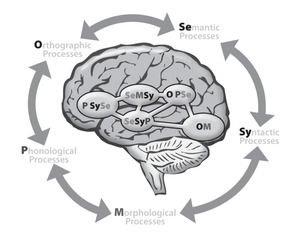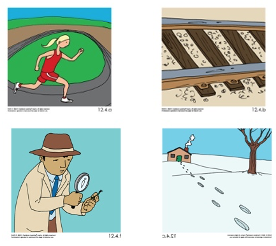The RAVE-O Approach: Building Fluency Among Students with Rapid Automatized Naming (RAN) Weaknesses
When I present on the topic of fluency, I ask the audience to describe the process in their own words. Defining fluency comes easily to most elementary educators, and the group usually lands on a variation of the following description: Fluency is accurate, prosodic reading that sounds like natural speech and is automatic enough to allow for attention to meaning.
Would you agree? Certainly, it is an accurate characterization of the behavior of a fluent reader and well aligned with findings from the National Reading Panel (2000).
Then, I move onto the next challenge, and I ask the group to describe how fluent reading occurs. By what mechanism does a student move from word by word or sound by sound reading to fluency? This question generates much more debate and a consensus is not always reached. Many educators believe that models of phrasing paired with practice act as the primary method, but others are not convinced. They describe students for whom the process moves at a painstaking pace.
This blog was written to unpack the development of fluency, particularly among struggling readers and those with Rapid Automatized Naming weaknesses. I will highlight recent research that implies fluency results when students simultaneously activate multiple aspects of word knowledge. That means as fluent students encounter words, they initially retrieve information about letters and corresponding sounds, but nearly instantaneously also activate additional aspects of word knowledge like vocabulary, parts of speech, grammar, and morphological information.
The instructional implications from these findings are numerous and spotlight the importance of a multilinguistic curricula that simultaneously and explicitly teaches students all aspects of word knowledge. One structured literacy curriculum that features a multilinguistic approach is RAVE-O®. In fact, research studies that examined the effectiveness of RAVE-O found that among students with Rapid Automatized Naming weaknesses, it was more effective then phonics alone and made a more significant impact on fluency and comprehension skills than a repeated reading approach.
How does fluency develop?
Consider the following passage from the Gray Oral Reading Test (GORT-4). The audio clip below is a compilation of four different students reading the passage. As you listen to their reading, which do you think was most fluent?
A man got out of the car.
He had a pretty box under his arm.
A little girl ran from the house to meet him.
“Hello, father,” she said.
“Do you have a surprise for me?”
Father said, “I have something for a good girl.”
The girl laughed, “I am very good.”
He had a pretty box under his arm.
A little girl ran from the house to meet him.
“Hello, father,” she said.
“Do you have a surprise for me?”
Father said, “I have something for a good girl.”
The girl laughed, “I am very good.”
Most would agree, the final reader was the most fluent. He was largely accurate, aware of punctuation, and appeared to monitor his comprehension. He used inflection when encountering dialogue, and was clearly aware of questions, and exclamations (even adding a bit of an accent for dramatic flair). Would it surprise you to hear the student was diagnosed with dyslexia one year prior and this recording was captured after 100 hours of intervention? How did he become fluent? What was happening in the brain of our fluent reader and how does it help us plan instruction for others?
How to build fluency in students with weak RAN scores
One of the most prevalent approaches to building fluency, repeated reading instruction, is based on the premise that the rehearsal of text—in which students re-read phrases, sentences, and selections of passages—will bolster automaticity and prosody with written language. Although repeated reading provides a useful platform for practice, it does not always provide the explicit support necessary for many struggling readers especially those with weaknesses in Rapid Automatized Naming (RAN).
RAN is a measure of students’ ability to retrieve a verbal label (or name) for a given symbol (object, letter, number, or color). Rate of retrieval is highly predictive of later reading automaticity (Norton & Wolf, 2012) because the processing required for a RAN task involves the same neurological mechanisms that are active in the brain’s “reading circuit.” Reports of students’ scores on RAN measures are becoming more common as dyslexia screening and eligibility testing expands nationally.
As educators work to differentiate instruction among their struggling readers, indicators like Below Average scores in Rapid Automatized Naming (also referred to as Naming Speed) provide insights into the root cause of students’ challenges. As noted earlier, there is significant evidence to suggest that for students with low RAN scores to achieve fluency, they must become automatic not only in their retrieval of sounds in a word (phonology) and common letter patterns (orthography) which is the emphasis of phonics instruction, BUT ALSO word meaning (semantic), part of speech (syntax) and how the word might change with a prefix or suffix (morphology).
Going beyond repeated reading to offer strategic instruction
Together, Phonology, Orthography, Semantics, Syntax, and Morphology form the five aspects of word knowledge, what I will refer to as POSSuM skills. These skills map directly onto the areas of the brain that are activated during fluent reading (see Figure 1).
Figure 1: How POSSuM Maps onto the Reading Circuit
Thinking back to the audio clip, it was the final reader who was first, accurate in his reading (retrieving sight words and sound/symbol knowledge for decoding), but also familiar with word meaning, phrasing, and the impact of prefixes and suffixes. He utilized all of this information to visualize the story and that further enhanced his comprehension.
When teachers provide direct, intensive, and systematic instruction across all of the POSSuM elements of word knowledge they offer the stimulus necessary to activate all areas of word knowledge, and thereby increase fluency and comprehension across all levels of text reading.
The RAVE-O approach
The RAVE-O (Reading through Automaticity, Vocabulary, Engagement, and Orthograph) program is purposefully designed to include near simultaneous instruction on all of the POSSuM elements.
RAVE-O begins by situating students in RAVE-O Town, a whimsical far-away land, where colorful characters teach students linguistic strategies that improve their fluency and comprehension. Ms. MIM, a wise and amiable spider informs students that just like a spider has many legs, words can have Many Interesting Meanings (i.e. track), and those meanings are connected to each other through her word web. The Ender Bender characters remind students that suffixes attach to the end of the base word and often bend or change its meaning (i.e. track, tracks, tracked, tracker). The speedy little sports coupe, S Car Go, is a strategy to remind students about the spelling conventions that govern suffixes. S happens to be an Ender Bender that can easily be added to a base word without adjusting the spelling, you can just add an “S” and go…S Car Go (i.e. jams…jamming, taps…tapping).
Yet the essence of RAVE-O content lives within a set of 96 core words that were purposefully selected for their ability to teach children both common letter patterns and the semantic concept of multiple meaning. Lessons follow a similar sequence that support the consolidation of new knowledge and retrieval during single word and connected text reading and spelling.
Table 1: Sample RAVE-O Lesson Outline
| Activity | Description | Sample: TRACK | ||
|---|---|---|---|---|
Core Word Introduction (Five minutes) | Each lesson begins with the introduction of at least one new core word, and a vocabulary activity that supports students’ knowledge of multiple meaning with illustrated cards. These activities enhance automatic word retrieval by anchoring phonetic aspects of the word to the students’ vocabulary knowledge. |  | ||
Building & Reading Words (Eight minutes) | Next, students identify the sounds in the word and match them to the correct letter patterns. Then, they practice developing automaticity by creating words with similar word parts highlighting either the rime or initial consonant (single or blend) patterns. |
| ||
Reading Words in Sentences (Eight minutes) | As the lesson moves into sentence reading, students discuss parts of speech, identifying the job the word plays in the sentence and practicing the recognition and comprehension of suffixes. |
| ||
Spelling Word Parts, Words and Sentences (Eight minutes) | Students are provided with the opportunity to practice encoding through regular dictation activities that support the retrieval of word parts, single decodable and irregular words, and sentences. |
| ||
Reading Passages (Eight minutes) | Most lessons culminate with passage reading in RAVE-O Minute Stories where the multiple meanings and word families are highlighted. |  |
Compelling evidence for RAVE-O
The impact of the POSSuM approach, or a similar multicomponential approach to developing automaticity across all aspects of word knowledge, has been evaluated in multiple large-scale longitudinal studies which followed the impact of interventions. In fact, there is mounting evidence to demonstrate that RAVE-O can be more effective than repeated reading, and/or phonics instruction alone in developing fluency and comprehension among students with weaknesses in RAN.
The first longitudinal study found that approximately 300 racially, and socio-economically diverse struggling readers who received 70 hours of a phonics program combined with RAVE-O made more significant gains in reading fluency and comprehension than those who received phonics instruction alone Morris et al., 2011).
The second longitudinal study evaluated the combination of RAVE-O and another multicomponential program Empower (Lovett, Steinbach & Frijters, 2000), thus amplifying the impact on a separate group of diverse elementary-aged struggling readers. These students made gains on GORT Oral Reading Fluency and Reading Comprehension equivalent to a medium effect (d = .76) and large effect (d =.90) respectively (Lovett et al., 2017). This effect is larger than effects procured by interventions that focused on building fluency through repeated reading (National Reading Panel, 2000).
These robust studies support the mounting evidence that instruction on multiple components of the reading circuit is essential to producing substantial effects on fluency and comprehension among students with Naming Speed weaknesses.
Register for Webinar
References
Bowers, P. G., & Swanson, L. B. (1991). Naming speed deficits in reading disability: Multiple measures of a singular process. Journal of experimental child psychology, 51(2), 195-219.
Lovett, M. W., Frijters, J. C., Wolf, M., Steinbach, K. A., Sevcik, R. A., & Morris, R. D. (2017). Early intervention for children at risk for reading disabilities: The impact of grade at intervention and individual differences on intervention outcomes. Journal of Educational Psychology. doi:10.1037/edu0000181
Lovett, M. W., Steinbach, K. A., & Frijters, J. C. (2000). Remediating the core deficits of developmental reading disability A double-deficit perspective. Journal of learning disabilities, 33(4), 334-358.
Miller, C. J., Miller, S. R., Bloom, J. S., Jones, L., Lindstrom, W., Craggs, J., . . . Hynd, G. W. (2006). Testing the double-deficit hypothesis in an adult sample. Annals of Dyslexia,56(1), 83-102. doi:10.1007/s11881-006-0004-4
Morris, R.D., Lovett, M.W., Wolf, M., Sevcik, R.A., Steinbach, K.A., , J.C., & Shapiro, M. (2011). Multiple-component remediation for developmental reading disabilities: IQ, SES, and Race as factors on remedial outcome. Journal of Learning Disabilities, May 5, 2010, pp 1-29.
National Reading Panel. (2000). Teaching children to read: An evidence-based assessment of the scientific literature on reading and its implications for reading instruction. Washington, DC: National
Norton, E. S., & Wolf, M. (2012). Rapid automatized naming (RAN) and reading fluency: Implications for understanding and treatment of reading disabilities. Annual review of psychology, 63, 427-452.
Wolf, M., Bowers, P. G., & Biddle, K. (2000). Naming-speed processes, timing, and reading A conceptual review. Journal of learning disabilities, 33(4), 387-407.


